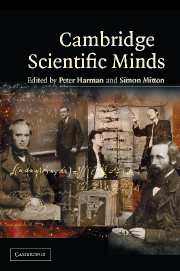Book contents
- Frontmatter
- Contents
- Foreword
- Introduction
- 1 William Gilbert
- 2 William Harvey
- 3 Isaac Newton: Creator of the Cambridge scientific tradition
- 4 William Whewell: A Cambridge historian and philosopher of science
- 5 Adam Sedgwick: A confident mind in turmoil
- 6 Charles Babbage: Science and reform
- 7 Charles Darwin
- 8 Stokes and Kelvin, Cambridge and Glasgow, light and heat
- 9 James Clerk Maxwell
- 10 The duo from Trinity: A.N. Whitehead and Bertrand Russell on the foundations of mathematics, 1895–1925
- 11 Thomson, Rutherford and atomic physics at the Cavendish
- 12 Hopkins and biochemistry
- 13 Charles Sherrington, E.D. Adrian, and Henry Dale: The Cambridge Physiological Laboratory and the physiology of the nervous system
- 14 Hardy and Littlewood
- 15 Arthur Stanley Eddington
- 16 Paul Dirac: A quantum genius
- 17 Alan Turing
- 18 Francis Crick and James Watson
- 19 Mary Cartwright
- 20 Joseph Needham
- 21 Molecular biology in Cambridge
- 22 The discovery of pulsars – prelude and aftermath
- 23 Stephen W. Hawking
18 - Francis Crick and James Watson
Published online by Cambridge University Press: 05 June 2014
- Frontmatter
- Contents
- Foreword
- Introduction
- 1 William Gilbert
- 2 William Harvey
- 3 Isaac Newton: Creator of the Cambridge scientific tradition
- 4 William Whewell: A Cambridge historian and philosopher of science
- 5 Adam Sedgwick: A confident mind in turmoil
- 6 Charles Babbage: Science and reform
- 7 Charles Darwin
- 8 Stokes and Kelvin, Cambridge and Glasgow, light and heat
- 9 James Clerk Maxwell
- 10 The duo from Trinity: A.N. Whitehead and Bertrand Russell on the foundations of mathematics, 1895–1925
- 11 Thomson, Rutherford and atomic physics at the Cavendish
- 12 Hopkins and biochemistry
- 13 Charles Sherrington, E.D. Adrian, and Henry Dale: The Cambridge Physiological Laboratory and the physiology of the nervous system
- 14 Hardy and Littlewood
- 15 Arthur Stanley Eddington
- 16 Paul Dirac: A quantum genius
- 17 Alan Turing
- 18 Francis Crick and James Watson
- 19 Mary Cartwright
- 20 Joseph Needham
- 21 Molecular biology in Cambridge
- 22 The discovery of pulsars – prelude and aftermath
- 23 Stephen W. Hawking
Summary
The twentieth century has witnessed a remarkable transformation in the scientific status, economic importance, and public visibility of biology. The new knowledge that lay behind this transformation was based upon scientific achievements that were made in research institutes and universities in many parts of the world beginning in the fifties. A major foundation for such success was laid when Francis Crick and James Watson, working at the time in Cambridge, suggested that deoxyribonucleic acid or DNA – the stuff of our genes – is constructed of two helical long-chain molecules wound around each other – the now-famous Double Helix. Their brief paper describing the structure in the journal, Nature, in 1953, has since become one of the most famous in the history of twentieth-century science.
The Double Helix, its structure suggestive of its function as repository of the specificities or ‘information’ of our genes and of the molecular mechanism by which the genes are duplicated, supplied the foundation upon which could be built our understanding of genetics at the molecular level. It clinched the debate already under way in favour of the nucleic acids rather than the proteins as the substance of the genes, and inspired the search for the hereditary codescript in which the genes are written. Along with the revelations of the molecular structure of the proteins, this new knowledge has made possible the development of molecular tools with which to manipulate the genetic material for the benefit of medicine and agriculture, diagnostic tests to guide preventive medical advice, and an identity test – DNA fingerprinting – to aid forensic science.
- Type
- Chapter
- Information
- Cambridge Scientific Minds , pp. 269 - 281Publisher: Cambridge University PressPrint publication year: 2002



